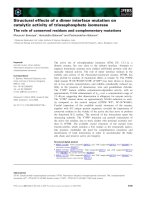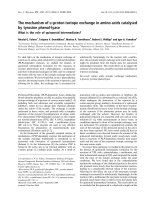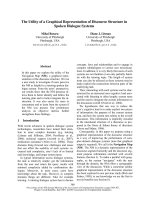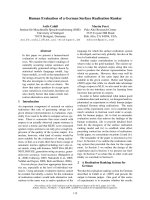báo cáo khoa học: "Successful treatment of a free-moving abdominal mass with radiation therapy guided by conebeam computed tomography: a case report" potx
Bạn đang xem bản rút gọn của tài liệu. Xem và tải ngay bản đầy đủ của tài liệu tại đây (834.95 KB, 4 trang )
CAS E REP O R T Open Access
Successful treatment of a free-moving abdominal
mass with radiation therapy guided by cone-
beam computed tomography: a case report
Bouthaina Dabaja
1*
, Kelly J Perrin
1
, Jorge E Romaguera
2
, Patricia Horace
1
, Christine F Wogan
1
, Ferial Shihadeh
1
,
Mohammad R Salehpour
3
Abstract
Introduction: Because tumors in the abdomen can change pos ition, targeting these tumors for radiation therapy
should be done with caution; use of daily image-guided radiation therapy is advised.
Case presentation: We report the c ase of a 72-year-old Caucasian man with recurrent mantle cell lymphoma who
was referred for palliative radiation therapy for an abdominopelvic tumor. Computed tomography was used to
generate images for radiation treatment planning. Comparison of those planning images with a positron emission
tomography/computed tomography scan ordered during the planning period revealed that the tumor had moved
from one side of the abdomen to the other during the three-day interval between scans. To account for this
unusual tumor movement, we obtained a second set of planning computed tomography scans and used a Varian
cone-beam computed tomography scanner with on-board imaging capability to target the tumor before each
daily treatment session, leading to successful treatment and complete resolution of the mass.
Conclusion: Abdominal masses associated with the mesentery should be considered highly mobile; thus, radiation
therapy for such masses should be used with the utmost caution. Modern radiation therapy techniques offer the
ability to verify the tumor location in real time and shift the treatment ports accordingly over the course of
treatment.
Introduction
One of the most important challenges for the safe deliv-
ery of radiation therapy is the accurate application
of three-dimensional conformal radiation therapy
(3DCRT). The application of computed tomography
(CT) in the 1970s to generate beam’s-eye view images
spurred the developmen t of CT-based treatment simul a-
tion and planning for 3DCRT [1,2]. The benefit of con-
formal therapy lies in targeting the tumor area with
smaller radiation fields while sparing the surrounding
critical organs. But the ben efit of better targeting came
with the additional challenge of creating consistently
reproducible means of positioning patients for multiple
treatment sessions. Maintaining reproducibility among
treatments involves multiple issues, including the
devices used for patient immobilization and accounting
for differences in set-up between sessions, changes i n
tumor size or volume between sessions, and the motion
of internal organs during and between sessions. The
International Commission on Radiation Units and M ea-
surements (ICRU) addressed the issue of consistency in
volume and dose specifications in radiation therapy in
consecutive reports p ublished between 1978 and 1999
[3-5]. These reports gave the radiation oncology com-
munity a consistent language and methodology for
image-based, tumor volume-ba sed treatment planning.
Nevertheless, some patients present with tumors in loca-
tions that do not conform to known rules, and therefore
treatments prescribed according to guidelines such as
the ICRU reports can potentially miss the target and
mistreatthepatient.Herewedescribethecaseofa
patient who presented with an abdominopelvic lym-
phoma mass that could have been completely missed
* Correspondence:
1
Department of Radiation Oncology, The University of Texas MD Anderson
Cancer Center, Houston, Texas 77030, USA
Full list of author information is available at the end of the article
Dabaja et al. Journal of Medical Case Reports 2010, 4:329
/>JOURNAL OF MEDICAL
CASE REPORTS
© 2010 Dabaja et al; licensee BioMed Central Ltd. This is an Open Access article distributed under the terms of the Creative Commons
Attribution License (htt p://creativecommons.org/licenses/by/2.0), which permits unrestricted use, distribution, and reproduction in
any medium, pro vided the original work is properly cited.
with conventionally planned treatment ports because of
the extensive motion of the tumor within the abdomen.
Case presentation
We present the case of a 72-year-old Caucasian man
originally diagnosed in 2003 with stage IA mantle cell
lymphoma, nodular pattern, involving the right parotid
gland. At that time, he was treated with definitive radia-
tion therapy to a total dose of 36 Gy, and the disease
was in remission until 2006. He presented in July 2006
with shortness of breath and was found to have a right
pleural effusion. Thoracocentesis confirmed the recur-
rence of mantle cell lymphoma. Disease restaging work-
up revealed multicompartment lymphadenopathy in the
neck, mediastinal, retrocrural, retroperitoneal and pelvic
regions. Bone marrow was al so involved. The patient
was treated with a total of six cycles of rituximab, cyclo-
phosphamide, vincristine, doxorubicin and dexametha-
sone (R-HyperCVAD) completed in January 2007. That
treatment led to c omplete remission that lasted until
October 2008, when the disease was found to have
recurred in the left pleural space and retroperitoneum
without bone marrow involvement. At that time, the
patient was started on rituximab and lenalidomide but
developed secondary and prolonged pancytopenia (white
blood cell count, 1200 × 10
3
/μL [1200 × 10
9
/L]; neutro-
phils, 70%; hemoglobin, 7.6 g/dL [76 g/L]; platelets, 20 ×
10
3
/μL[20×10
9
/L]) after the second cycle that pre-
cluded further chemotherapy or surgical resection. In
April 200 9, the patient was referred to radiation oncol-
ogy to consider a palliative course of radiation to both
the pleural-based and the retroperitoneal masses. The
most urgent problems at that time were abdominal pain
and early signs of bowel obstruction secondary to an
abdominal mass. The 7.5 cm × 5.3 cm mass was located
in the left midpelvic region within the small bowel
mesentery anteriorly located beneath the abdominal
wall. Coronal (Figure 1, left) and sagittal (Figure 2, left)
CT scans showed that the mass extended from the
lower part of vertebral body L5 to the upper part of ver-
tebral body S2. Disease was evid ent in the medias tinum
and right pleural area but was not causing any symp-
toms at that time, and the decision was made to admin-
ister palliative radiation to the abdominal mass.
Radiation treatment was simulated and planned based
on CT scanning as follows. CT scans (5-mm slices)
were obtained over the course of several days for plan-
ning purposes; the target volume was outlined on those
scans, and a radiation therapy plan was generated by a
Pinnacle treatment planning system (version 8.0, Philips
Medical Systems, Madison, Wisconsin, USA). During
the planning process, the medical oncologist ordered a
positron emission tomography (PET)/CT scan. When
the results of that scan became available three days
later, the radiation oncologist noticed that the location
of the tumor mass on the radiation planning CT scan
was c ompletely different than its location on the PET/
CT sca n. At that time, the patient was brought back to
radiation oncology, ano ther planning CT scan series was
obtained, and the two sets of planning CT scans taken
five days apart were compared. We found and con-
firmed that the tumor mass had moved in three dimen-
sions, from the left side to the right side, from the lower
pelvis to the above the pelvic rim, and from a mid ante-
roposterior location to a more anterior location, over
those five days (Figures 1 and 2). We decided at that
point to proceed with the treatment usi ng a cone-beam
CT device equipped with on-board imaging (Varian
Medical Systems Inc., Palo Alto, California, USA). Cone-
beam CT provides volumetric images in real time while
the patient is immobilized in the treatment position
immediately before each treatment session. We obtained
cone-beam CT scans immediately before each daily
treatment, which the treating radiation oncologist used
to move the beam’s-eye views (anteroposterior and pos-
teroanterior) such that t he tumor was contained within
the radiation port. Because the extent of tumor motion
ranged between 3 and 7 cm in all three dimensions and
Figure 1 Coronal treatment-planning computed tomography
scans obtained five days apart showing the abdominal tumor
in two distinctly different locations.
Figure 2 Sagittal treatment-planning computed tomography
scans obtained five days apart showing the abdominal tumor
in two distinctly different locations.
Dabaja et al. Journal of Medical Case Reports 2010, 4:329
/>Page 2 of 4
because we could not predict the direction or the extent
of movement, we concluded that using cone-beam CT
for daily verification of tumor position was the only way
to effectively treat this mass.
The patient completed radiation therapy to a total
dose of 36 Gy given in 18 treatment sessions. The
volume of the mass decreased in from 213.9 cm
3
before
the radiation therapy to 70.2 cm
3
at the completion of
the radiation therapy.
To as sess the potential differences in dose distribution
between the originally planned treatment and the treat-
ment actually delivered with the use of cone-beam CT,
we fused the origi nal planning CT scans with the cone-
beam CT scans obtained on selected treatment days and
contoured the tumor to illustrate the shift in its location
from day to day (Figure 3). We also generated dose-
volume histograms for ea ch daily tumor location assess-
ment to show the doses that would have been received
if the original planning fields had been applied without
the use of cone-beam CT (Figure 4). That analysis
shows that up to 80% of the tumor volume would have
been missed in several instances.
Side effects of the radiation treatment included diar-
rhea and fatigue. Because the m ass never intercepted
either kidney, no radi ation was accidentally delivered to
the kidneys. The patient returned for follow-up four
weeks after completion of treatment, at which time a
second PET/CT scan showed complete resolution of the
treated mass (Figure 5) and no other masses in the
abdomen.
Discussion
Accounting for internal organ motion is a major pro-
blem in treating abdominal tumors with radiation ther-
apy. Tumors attached to the mesentery can move
significantly more than tumors located in the retroperi-
toneal region. Before the era of 3DCRT, the abdominal
mass in this patient would have been missed in the
course of daily treatments. Our use of cone-beam CT
with on-board imaging capability w as extremely useful
in this case and allowed us to successfully treat this
patient. Cone-beam CT was originally explored by
Simpson et al. [6] as a way of generating single-slice
tomograms w ith one gantry rotation of the l inear parti-
cle accelerator (LINAC). Currently, several solutions
involving CT image acquisition have been i ntroduced
into routine clinical use [7-9]. The concept of cone-
based CT is based on integrating a kilovoltage (kV)
x-raysourceandalarge-areaflatpaneldetectorona
Figure 3 Isodose lines drawn on transverse (left), sagittal
(middle) and coronal (right) computed tomography (CT) scans
illustrating changes in tumor location on the daily cone-beam
CT images.
Figure 4 Dose-volume histogram illustrating the doses that would have been delivered if cone-beam computed tomography had not
been used.
Dabaja et al. Journal of Medical Case Reports 2010, 4:329
/>Page 3 of 4
standard LINAC to allow simultaneous fluoroscopy,
radiography and volumetric kV cone-beam CT imaging.
A volumetric CT image is reconstructed from data col-
lected during a single gantry rotation.
Theuncertaintyofthedosedistributionthatwould
have been received by the tumor if conventional radia-
tion planning techniques had been used is the core mes-
sage of this report. We showed that the tumor would
have been almost completely missed in several instances.
Moreover, the cone-beam approach also allowed us to
account for decreases in tumor size as well as position
over t he course of treatment, so the difference in
planned dose distribution would have been ev en greater
if daily changes in the tumor volume had not been
acco unted for. In light of the variable and unpredictable
daily movement of the mesenteric mass, the tumor mass
would definitely have received inadequate coverage and
some days would have been completely missed b y the
radiation fields. We conclude from this experience that
image-guided radiation therapy is both valid and useful
for tracking the motion of highly mobile abdominal
masses.
Conclusion
This report is intended as a cautionary note to the
radiation oncology community to use care when treating
mesenteric-based masses in the abdo men because such
masses can move substan tial distances and can easily be
missed if treatment is planned according to the c urrent
3DCRT guidelines.
Consent
Written informed consent was obtained from the patient
for publication of this case report and accompanying
images. A copy of the written consent is available for
review by the Editor-in-Chief of this journal.
Abbreviations
CT: computed tomography; kV: kilovoltage; PET: positron emission
tomography; 3DCRT: three-dimensional conformal radiotherapy.
Acknowledgements
This report was derived in the course of the authors’ normal duties; no
funding sources were involved.
Author details
1
Department of Radiation Oncology, The University of Texas MD Anderson
Cancer Center, Houston, Texas 77030, USA.
2
Department of Lymphoma/
Myeloma, The University of Texas MD Anderson Cancer Center, Houston,
Texas 77030, USA.
3
Department of Radiation Physics, The University of Texas
MD Anderson Cancer Center, Houston, Texas 77030, USA.
Authors’ contributions
BD analyzed and interpreted the patient data regarding the radiation
treatment. MRS analyzed the technical data, particularly use of the cone-
beam CT. PH helped obtain consent and provided patient care. KJP
generated comparative plans. JER was the medical oncologist. CFW drafted
the manuscript and revised it for intellectual content. All authors read and
approved the final version of the manuscript.
Competing interests
The authors declare that they have no competing interests.
Received: 3 December 2009 Accepted: 19 October 2010
Published: 19 October 2010
References
1. Levene MB, Kijewski PK, Chin LM, Bjarngard BE, Hellman S: Computer-
controlled radiation therapy. Radiology 1978, 129:769-775.
2. Sterling TD, Perry H, Weinkam JJ: Automation of radiation treatment
planning. V. Calculation and visualisation of the total treatment volume.
Br J Radiol 1965, 38:906-913.
3. International Commission on Radiation Units and Measurements (ICRU
Report 62): Prescribing, recording, and reporting photon beam therapy
(supplement to ICRU Report no.50). Bethesda, MD 1999.
4. International Commission on Radiation Units and Measurements (ICRU
Report 50): Prescribing, recording, and reporting, photon beam therapy.
Bethesda, MD 1993.
5. International Commission on Radiation Units and Measurements (ICRU
Reprt 29): Dose specification for reporting external beam therapy with
photons and electrons. Washington, DC 1978.
6. Simpson RG, Chen CT, Grubbs EA, Swindell W: A 4-MV CT scanner for
radiation therapy: the prototype system. Med Phys 1982, 9:574-579.
7. Jaffray DA, Siewerdsen JH, Wong JW, Martinez AA: Flat-panel cone-beam
computed tomography for image-guided radiation therapy. Int J Radiat
Oncol Biol Phys 2002, 53:1337-1349.
8. Oelfke U, Tücking T, Nill S, Seeber A, Hesse B, Huber P, Thilmann C: Linac-
integrated kV-cone beam CT: technical features and first applications.
Med Dosim 2006, 31:62-70.
9. Yoo S, Kim GY, Hammoud R, Elder E, Pawlicki T, Guan H, Fox T, Luxton G,
Yin FF, Munro P: A quality assurance program for the on-board imagers.
Med Phys 2006, 33:4431-4447.
doi:10.1186/1752-1947-4-329
Cite this article as: Dabaja et al.: Successful treatment of a free-moving
abdominal mass with radiation therapy guided by cone-beam
computed tomography: a case report. Journal of Medical Case Reports
2010 4:329.
Figure 5 Positron emission tomography/computed
tomography images obtained before (left) and after (right) an
18-session course of radiation therapy.
Dabaja et al. Journal of Medical Case Reports 2010, 4:329
/>Page 4 of 4







![Tài liệu Báo cáo khoa học: Specific targeting of a DNA-alkylating reagent to mitochondria Synthesis and characterization of [4-((11aS)-7-methoxy-1,2,3,11a-tetrahydro-5H-pyrrolo[2,1-c][1,4]benzodiazepin-5-on-8-oxy)butyl]-triphenylphosphonium iodide doc](https://media.store123doc.com/images/document/14/br/vp/medium_vpv1392870032.jpg)

